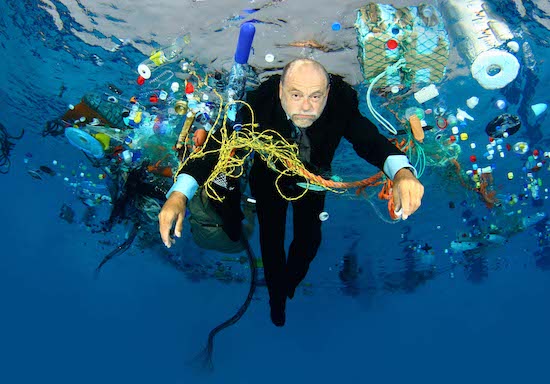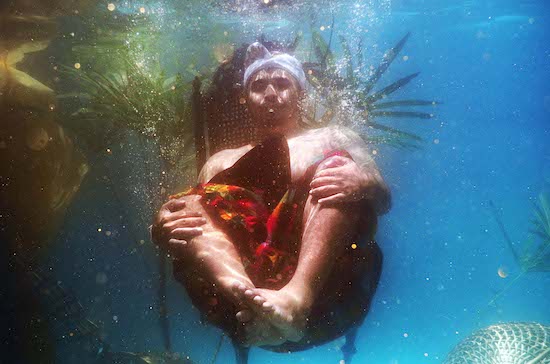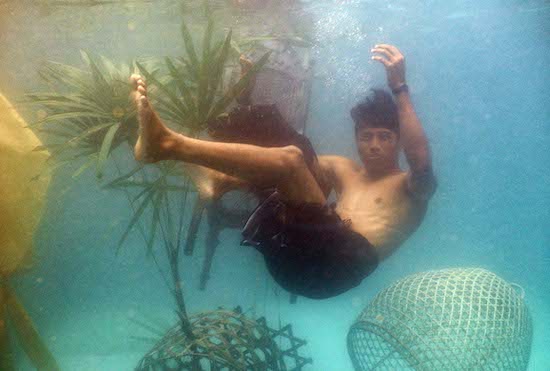Susana Sanromán is a photographer from Galicia, Spain, based in London. At her first solo exhibition at the Leico Studio, Mayfair, Brit.es launches its latest book, Dystopia, featuring Sanromán’s pictures of men and woman drowning, caught in plastic. This is the third issue in the series of their pocket photobooks featuring Spanish artists who work in or from the UK. Reflecting on rising sea levels through staging near-future realities, Dystopia reflects on the importance of water for all animals. Humans are 60% water, the planet is 3/4 water. Watery theatre looks forward to tomorrow, in fear of calamity. Fictitious nightmares act out statistical projections of the effects of climate change.
The Mayfair white walls display this recent work, taken in Bali, Indonesia, and in Sanromán’s hometown of La Coruña. Initially inspired by working with the environmental artist Maria Jose Arceo, some years ago Sanromán began working on a series of mummifications, wrapping herself and models in waste materials and taking beautiful rich photos of the ‘mummies’ in significant ‘habitats’. I was myself one of these models one summer, standing precariously over a frightening abyss in the damaged floor of an abandoned paper factory, bits of paper that had been lying in the factory since its closure attached to cover me completely. The stop motion animation was powerful, testament to waste of industry and our responsibility to clear up after ourselves. And also a hymn to the melancholic seduction of our abandoned spaces. This series feels religious, a memory, a gravestone to the departed. This shoot was part of the series looking back at past human imprints in The Things We Leave Behind.
In contrast to the airy space of these empty factories and relics of industry, this new generation of Sanromán’s pictures have been photographed in deep water. Drawn to the movement and otherworldly qualities, the disorientating light and perspective, Sanromán has created a response to the plastic pollution infecting waterways and oceans. In these pictures it is not turtles and fish affected by the killing material but human beings, caught up in its tangles and snares.
Taken last year, Volume 1 Plastics. Spain. 2017 shows the members of the scuba diving club of La Coruña floating on the top of the swimming pool, shot by Sanromán with her underwater camera. A middle-aged businessman (actually chairman of the scuba club) floats face down on the surface. The bags and the nets of fishing sidle up to him. He has been trapped by the mess, suspended in an ugly surface in a trap of his own making. The colours shine out, royal blue, yellows, cadmium red out of the dark water. The bodies contort inhumanly, fluid and distended, moving in bizarre ways. Faces gurn and stare cartoon-like down at the photographer, and now, vertical at the wall eyes fix on the viewer, like accused ghosts not looking for rescue, but dramatising our current predicament where we are caught in our colourful party filth. With the mess of light shiny tones jumping out of the dark the characters are flash-photographed, an unholy second of movement in a hellish party. There’s an unconscious reference to the work of pop artists, Jeff Koons of course, but also many music videos and band photography.
The human body signifies society in Sanromán’s work. She uses the figures to stand for us all. Our predicament. Our life. Where we are. And what we are doing. Whereas her mummies seemed to signify the departed I feel as though her live humans, trapped in action, are caught just before the moment of death, in their last spluttering gasp at a devilish knees-up.

The second series, Volume 2. Atlantis. Indonesia 2017 is softer. The softness actually comes from the dust of Mount Agung which erupted while she was on the Circle artist residency last November. The towers of volcanic ash spewed into the sky were sublime but dangerous. Indonesian officials called for 100,000 people to leave the area. The artists were based far enough outside the exclusion zone not to be directly affected by the rapidly moving mudflows or to have ash falling like snow but the lighter levels of volcanic debris dropped from the air into the water and her photographs as the thundering explosions threw up the earth’s detritus.
These Bali photographs are gentler. Models float in the water with furniture, washed out, soft interiors displaced in what feel to me as captured memories of ancient apocalypse. Chairs, wicker baskets what look like house plants juggle around with the Indonesian models. Sanromán had to work with trusting non-professional local performers that could not swim, coaxing and supporting them, protecting them to achieve these ghostly pictures in which the performers challenge gravity. Behind the models the sun shines sweetly through the water, making a heavenly blue. The contaminants in the water pick up the golden light and reflect it like stars. The figures could be godly giants in the milky way. They drift and pose.

Sanromán is a respectful photographer to those who give their effort to work with her. She asks much but I can testify personally to the care she gives looking after her models. Without her attention to their well-being the mood in her pictures would be different, and I reckon her results owe a great deal to her personality as a photographer and the way she gives herself to the situation of the shoot.
She informed me that, broadly speaking, she would say there are different types of art photographers, or rather types of photography. There are the hunters who snap what they see, catching beauty, excitement, a special moment in light and action. Street photographers fall into this category. She is a farmer, setting up scenes, making the subject of her work happen.
Sanromán was the assistant of Tom Hunter known for his iconic images which reference Vermeer and important paintings from art history while telling stories of life in East London. She is, in fact, the model on the front cover of The Way Home. This experience of posing for the photograph has become essential to the way Sanromán works. Her own knowledge of the contribution of the model is present in every picture of Present Imperfect, Future Tense.
It’s a strong and promising exhibition from a mid- to early- career art photographer. As an occasional model and assistant I dread to think where she will go next.
Present Imperfect, Future Tense by Susana Sanromán is at Leica, Mayfair, until 9 November


